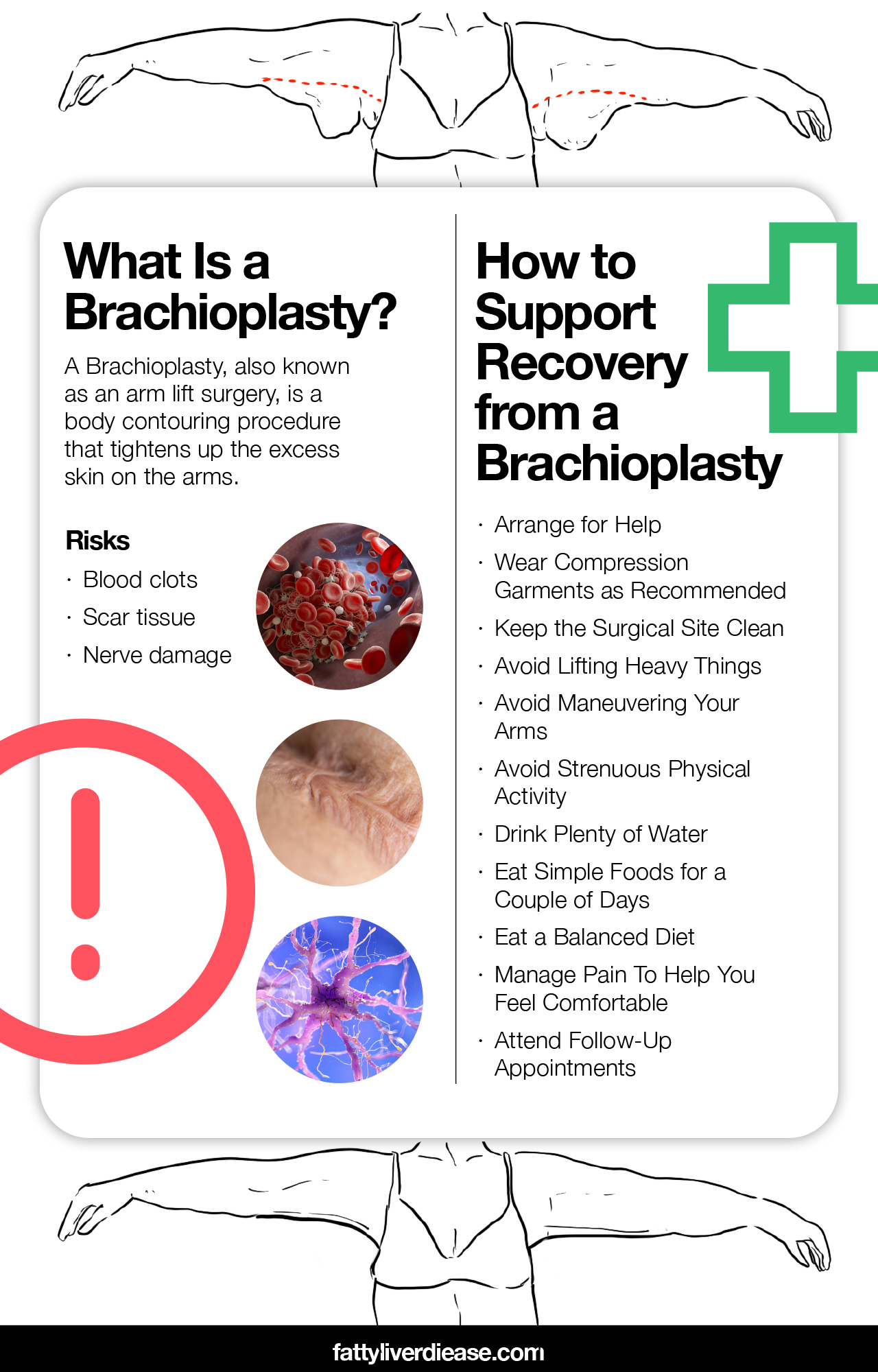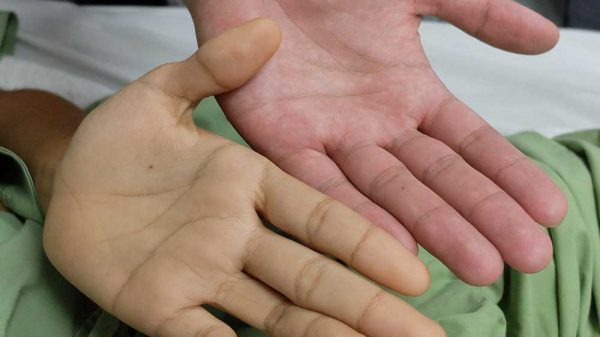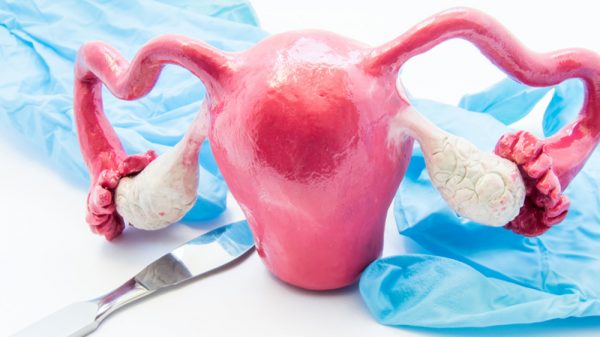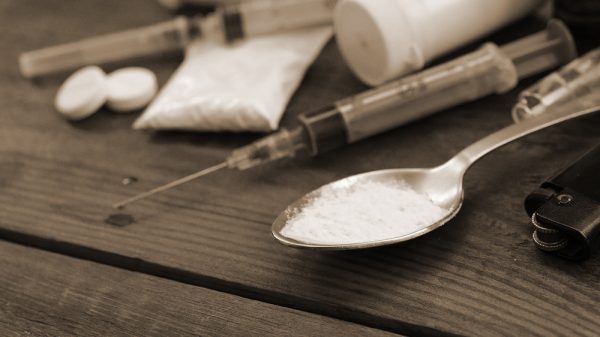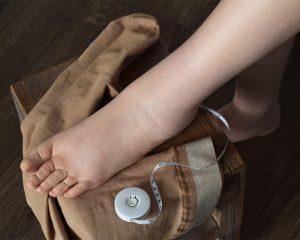Sagging skin in the underarm area is a common nuisance that many adults face. Loose arm skin may be more severe and bothersome if you have recently lost a significant amount of weight. In the case of loose skin, no amount of arm exercise can tighten up the flabbiness. If you find hanging arm skin constantly bothersome and cumbersome in your everyday life, you may benefit from an excess skin removal surgery on your arms.
When you are considering undergoing an arm lift surgery or a brachioplasty, it’s helpful to know what to expect during and after the procedure. Keep reading to find out everything you need to know about the brachioplasty surgery and how to support recovery.
What Is a Brachioplasty?
Are you wondering how to get rid of arm fat and excess skin? Arm surgery may be an option. A brachioplasty, also known as an arm lift surgery, is a body contouring procedure that tightens up the excess skin on the arms. In particular, an arm lift procedure targets the upper arm area between the armpit and elbow, since this is where loose skin tends to collect.
A brachioplasty procedure is conducted by a plastic surgeon. It’s a good idea to seek out a board-certified plastic surgeon to carry out your procedure since board-certified plastic surgeons have undergone more extensive and rigorous training.
Who Benefits from a Brachioplasty?
In many cases, individuals who benefit from a brachioplasty have recently lost a significant amount of weight. Significant weight gain followed by significant weight loss can result in significant stretching and destroy the elasticity in the skin. As a result, losing weight will leave a lot of excess skin throughout the body, but particularly in the stomach and the upper arms. Individuals who benefit from an arm lift procedure may experience:
- Infection: Hanging underarm skin can create folds that make it difficult to wash all areas around the arm, which can lead to the development of fungal and bacterial infections.
- Irritation: Having a significant amount of excess skin around the arms can cause chafing, leading to rashes, redness, and pain.
- Poor self-image: Individuals with sagging arm skin may find that their clothes don’t fit normally and feel self-conscious and embarrassed by the excess skin.
- Difficulty with daily tasks: In severe cases, excess skin may interfere with carrying out normal activities. If arm skin is particularly heavy or unwieldy, it may be cumbersome to move the arms around to do simple activities, such as reaching for a box of cereal on the top shelf.
Scheduling a Consultation
If you are bothered by hanging underarms and find that your quality of life suffers because of loose skin, it’s a good idea to book a consultation with a plastic surgeon. It’s a good idea to research surgeons in your area, look at before and after pictures in the online photo gallery, and read testimonials. You may also find that recommendations from friends and family are helpful. Either way, it’s comforting to know what the surgeon’s work looks like and to hear positive testimonials from others.
The surgeon will listen to your concerns and conduct a physical examination to assess your case of loose skin. The surgeon will be able to evaluate whether or not you are a good candidate to receive a brachioplasty procedure. One important factor surgeons will look for is whether you’ve maintained a stable weight for the past year or so. Significant fluctuations in weight can jeopardize outcomes of the brachioplasty procedure, causing the skin to stretch out again soon after recovery. The surgeon will always want to make sure that the results of the surgery will be sustainable, before performing the procedure.
What to Expect Before Surgery
Leading up to the procedure, you will need to undergo preoperative testing to ensure that all of your vitals are in good shape to undergo general anesthesia and to receive a procedure.
In the week leading up to surgery, your surgeon and nurses will advise you to stop all medications and supplements that have a blood-thinning effect. Taking blood-thinning medications increases the risk of bleeding during surgery.
In the hours leading up to surgery, you will be asked to limit or cease food intake and water intake. Always follow all preoperative instructions to help ensure that the procedure progresses as smoothly as possible.
What to Expect During Brachioplasty Surgery
During a brachioplasty surgery, you will be under general anesthesia, which means you won’t feel anything or be aware of anything throughout the duration of the procedure. In some cases, local anesthesia or IV sedation may be the chosen form of anesthetic.
The surgeon will then make incisions along your underarms, create new contours for your skin, and remove the excess skin. The kind of incisions made in your arms is highly dependent on how much excess skin you have and where it is distributed. Some individuals may require large incisions, while other patients may need small incisions.
Some surgeons may also perform liposuction at the same time as excess skin removal. However, this depends on each patient’s individual body composition. It’s also common to undergo other body contouring or body lift procedures such as a panniculectomy or tummy tuck while undergoing brachioplasty surgery.
Are There Risks Associated with Brachioplasty Surgery?
As with all surgical procedures, excess skin removal surgeries such as brachioplasty are associated with a few risks. Even though serious complications are rare, it’s a good idea to keep an eye out for worrying symptoms. Notify your surgeon and seek medical attention immediately if you are concerned.
- Blood clots: Blood clots are a possible complication following many different surgeries. The risk for blood clots arises from lying motionless for a significant period of time during the surgery, and immediately following recovery.
- Scar tissue: Though scarring occurs with all surgeries, there is always the risk of developing excess scar tissue. This may depend on surgical techniques as well as on your individual biochemistry.
- Nerve damage: Undergoing a brachioplasty procedure may cause some nerves in the skin are damaged. You may have numb spots on your arm that may dissipate over time, though some numbness may also persist.
What to Expect During Recovery
Following an arm surgery, you will likely experience pain, bruising, and swelling in the upper arm area. After about 2 weeks, much of the swelling and bruising will have subsided. Keep in mind, however, that it may take about a month for your body to completely heal from the surgery.
How to Support Recovery from a Brachioplasty
Supporting the recovery process after a brachioplasty is similar to strategies for supporting any body contouring procedure or plastic surgery, such as a panniculectomy, breast lift, or breast augmentation. Knowing how to support your recovery after surgery can help ensure that the healing process is as comfortable and fast as possible.
1. Arrange for Help
Following a brachioplasty, you will be very groggy after waking up from general anesthesia. You will be unable to drive yourself home, so it’s important that you arrange for a trusted friend or family member to drive you home from the hospital. In the days following surgery, you will also face challenges doing some daily activities as you heal. It’s a good idea to have your friend or family member help ensure that food and other necessities are accessible.
2. Wear Compression Garments as Recommended
Following your procedure, you will likely be wearing compression garments and your surgeon and nurses will advise that you wear them for a certain period of time. Compression garments are designed to facilitate the healing process by controlling swelling. You may also have drainage tubes in place to reduce fluid buildup and therefore also mitigate swelling.
3. Keep the Surgical Site Clean
Preventing infection is crucial following a brachioplasty procedure. Follow all instructions for looking after your wounds as they heal. You may be asked to avoid getting the bandages wet for the first 24 hours, or your nurse may show you how to reapply bandages.
4. Avoid Lifting Heavy Things
Your arms will be healing for a couple of weeks following the procedure. During this time, it’s important to avoid straining your arms and lifting heavy objects, which can risk injury and jeopardize your health and healing. Only resume heavy lifting once you have been cleared by your surgeon.
5. Avoid Maneuvering Your Arms
For a couple of weeks following the surgical procedure, you will feel tightness in the arms in your skin. As your skin adjusts to its new contouring, it’s better to avoid lifting your arms over your head or maneuvering your arms in a way that may strain the surgical site. Outstretching your arms can stretch the surgical site and result in tearing and bleeding.
6. Avoid Strenuous Physical Activity
Following any surgery, it’s best to avoid strenuous activity. Engaging in strenuous activity too soon after the procedure will strain your arms and increase the likelihood of tearing and swelling. Instead, rest your arms after surgery and allow them to heal.
Although strenuous physical activity is discouraged, it’s a good idea to engage in gentle walking to encourage healthy blood flow. Going for a walk can help prevent the formation of blood clots, while also ensuring that blood flow is adequate to help oxygen and nutrients reach the surgical site to facilitate healing.
7. Drink Plenty of Water
Staying hydrated after surgery helps keep your blood circulating so that your body can deliver oxygen and nutrients to the surgical sites. Drinking plenty of fluids can also help flush out waste materials and keep all of your organ systems functioning as well as possible, so your body can heal efficiently.
8. Eat Simple Foods for a Couple of Days
You will likely feel nauseous for a day or so following surgery, which is simply an after-effect of the anesthesia. Stick to foods that are soothing for the stomach and easy-to-digest, such as crackers, chicken noodle soup, yogurt, eggs, and toast. If nausea persists for longer than a day, it’s a good idea to notify your surgeon.
9. Eat a Balanced Diet
After nausea from general anesthesia has worn off, it’s crucial to transition to a healthy and varied diet. People tend to underestimate the importance of a healthy, balanced diet when recovering from surgery. Eating the right foods can strengthen your immune system against infection, while also supplying your body with the raw materials your body needs to heal. Here are the major components of a healthy post-surgery diet:
- Protein: Dietary protein offers essential amino acids which are critical for rebuilding muscle and skin tissue following surgery. Low-fat dairy and meat offer optimal ratios of essential amino acids for healing. Eating a variety of plant-based proteins like whole grains, beans, nuts, and seeds can also help ensure that you are getting all of the essential amino acids that your body needs to heal.
- Fruits and vegetables: Fruits and veggies are rich in micronutrients like vitamins, minerals, and antioxidants. Certain vitamins are known to be cofactors for cellular processes, meaning they are required for the processes to progress as needed. Vitamins, minerals, and antioxidants support the immune system while also facilitating cellular processes that are crucial for wound healing.
- Fiber: Fiber helps decrease systemic inflammation while also counteracting unpleasant side effects of opioid painkillers. Plant foods like fruits, vegetables, whole grains, nuts, seeds, and beans are rich in fiber.
10. Pain Management
Managing pain helps you feel as comfortable as possible during the healing process. Your surgeon will likely prescribe you a course of painkillers to help take care of any significant pain in the days following surgery. After you’ve finished the course of prescription painkillers, you can use over-the-counter pain medication like acetaminophen. However, you may be asked to avoid non-steroidal anti-inflammatory medications, which may increase the risk of bleeding.
11. Attend Follow-Up Appointments
Attending follow-up appointments is a crucial part of the recovery process. During follow-up appointments, your surgeon will want to assess the surgical sites and ensure that you are healing as expected. Follow-up appointments are also a great time to ask any questions and address any concerns.
Precautions and Things to Keep in Mind
Keep in mind that each individual may have a different journey to recovery, based on his or her personal needs and any health conditions that might be present. Always follow the guidelines and instructions set specifically for you by your surgeon.
If you notice any worrying symptoms such as excessive swelling, persistent pain, oozing, bleeding, and fever, it’s important to seek medical attention and notify your surgeon immediately.
Final Results
After you have made a full recovery, you will notice that your arms will have a more toned appearance. You will also notice that your arms fit better in your clothes, and you will likely find that daily activities become less challenging. You will also find it much easier to clean your arms, resulting in fewer infections. The results of the brachioplasty surgery may also help improve your self-confidence levels as you enjoy your new, smoother appearance.
Conclusion
Sagging skin in the arm area is common from the aging process and as a result of massive weight loss. Excess sagging skin can get in the way of leading a healthy, happy life. A brachioplasty or arm lift surgery can help address the extra skin and provide you with arms that are more toned. To support your recovery from a brachioplasty procedure, make sure to take steps to avoid strenuous activity, follow all instructions for wearing compression garments, and eat a healthy diet. The brachioplasty surgery, as well as other skin removal surgeries, can significantly improve your health and quality of life.
